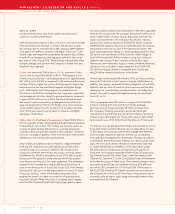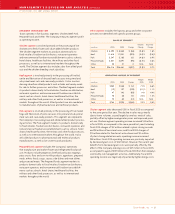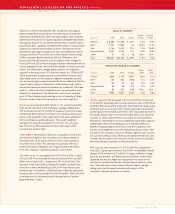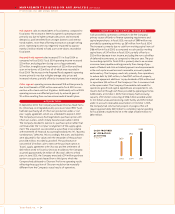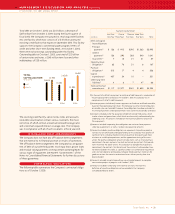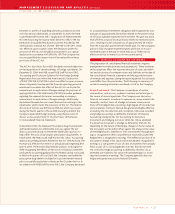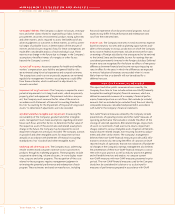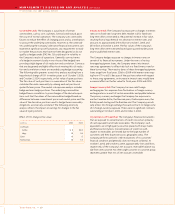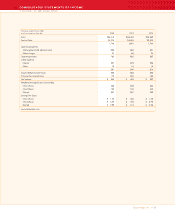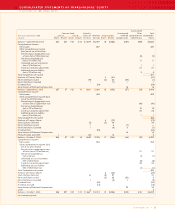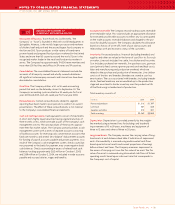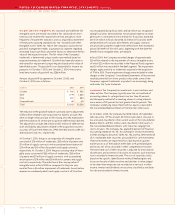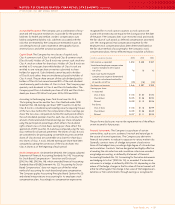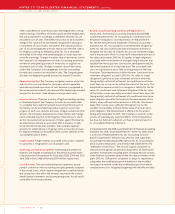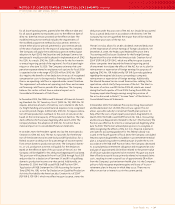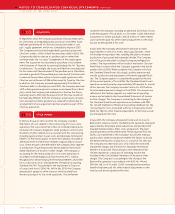Tyson Foods 2005 Annual Report Download - page 32
Download and view the complete annual report
Please find page 32 of the 2005 Tyson Foods annual report below. You can navigate through the pages in the report by either clicking on the pages listed below, or by using the keyword search tool below to find specific information within the annual report.
>> MANAGEMENT’S DISCUSSION AND ANALYSIS (CONTINUED)
TYSON FOODS, INC. 2005 ANNUAL REPORT
Tyson Foods, Inc. >> 30
Commodities Risk: The Company is a purchaser of certain
commodities, such as corn, soybeans, livestock and natural gas in
the course of normal operations. The Company uses commodity
futures to reduce the effect of changing prices and as a mechanism
to procure the underlying commodity. However, as the commodi-
ties underlying the Company’s derivative financial instruments can
experience significant price fluctuations, any requirement to mark-
to-market the positions that have not been designated or do not
qualify as hedges under SFAS No. 133 could result in volatility in
the Company’s results of operations. Generally, contract terms
of a hedge instrument closely mirror those of the hedged item
providing a high degree of risk reduction and correlation. Contracts
that are designated and highly effective at meeting this risk reduc-
tion and correlation criteria are recorded using hedge accounting.
The following table presents a sensitivity analysis resulting from a
hypothetical change of 10% in market prices as of October 1, 2005,
and October 2, 2004, respectively, on fair value of open positions.
The fair value of such positions is a summation of the fair values
calculated for each commodity by valuing each net position at
quoted futures prices. The market risk exposure analysis includes
hedge and non-hedge positions. The underlying commodities
hedged have a correlation to price changes of the derivative posi-
tions such that the values of the commodities hedged based on
differences between commitment prices and market prices and the
value of the derivative positions used to hedge these commodity
obligations are inversely correlated. The following sensitivity
analysis reflects the impact on earnings for changes in the fair
value of open positions.
Effect of 10% change in fair value
in millions 2005 2004
Livestock:
Cattle $ 3 $12
Hogs 13 18
Grain 15 5
Natural Gas 12 13
Interest Rate Risk: The Company has exposure to changes in interest
rates on its fixed-rate, long-term debt. Market risk for fixed-rate,
long-term debt is estimated as the potential increase in fair value,
resulting from a hypothetical 10% decrease in interest rates, and
amounts to approximately $47 million at October 1, 2005, and
$51 million at October 2, 2004. The fair values of the Company’s
long-term debt were estimated based upon quoted market prices
and/or published interest rates.
The Company hedges exposure to changes in interest rates on
certain of its financial instruments. Under the terms of various
leveraged equipment loans, the Company enters into interest
rate swap agreements to effectively lock in a fixed interest rate for
these borrowings. The maturity dates of these leveraged equipment
loans range from fiscal years 2006 to 2009 with interest rates rang-
ing from 4.7% to 6.0%. Because of the positions taken with respect
to these swap agreements, an increase in interest rates would have
a minimal effect on the fair value for fiscal years 2005 and 2004.
Foreign Currency Risk: The Company has non-cash foreign
exchange gain/loss exposure from fluctuations in foreign currency
exchange rates as a result of certain receivables and payable balances.
The primary currency exchanges the Company has exposure to
are the Canadian dollar, the Mexican peso, the European euro, the
British pound sterling and the Brazilian real. The Company periodi-
cally enters into foreign exchange forward contracts to hedge some
of its foreign currency exposure. There were no significant contracts
outstanding at October 1, 2005, and October 2, 2004.
Concentrations of Credit Risk: The Company’s financial instruments
that are exposed to concentrations of credit risk consist primarily
of cash equivalents and trade receivables. The Company’s cash
equivalents are in high quality securities placed with major banks
and financial institutions. Concentrations of credit risk with
respect to receivables are limited due to the large number of
customers and their dispersion across geographic areas. The
Company performs periodic credit evaluations of its customers’
financial condition and generally does not require collateral. At
October 1, 2005, and October 2, 2004, approximately 13.0% and 15.0%,
respectively, of the Company’s net accounts receivable balance was
due from one customer. No other single customer or customer group
represents greater than 10% of net accounts receivable.


